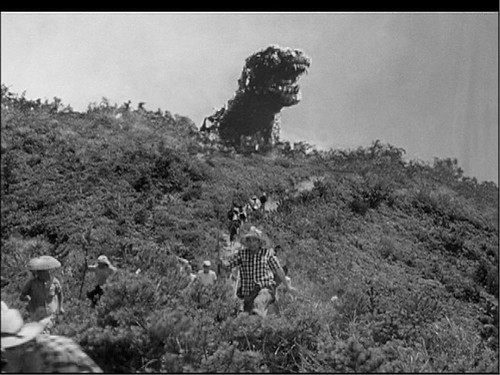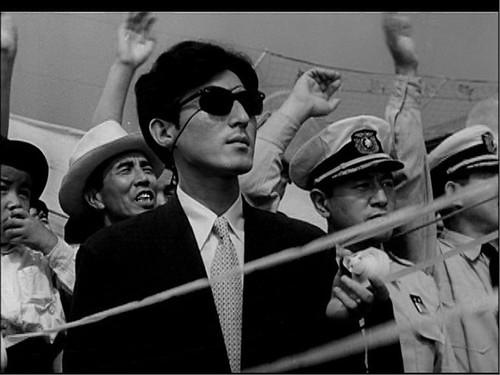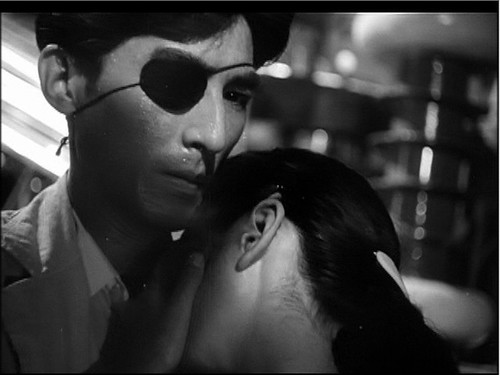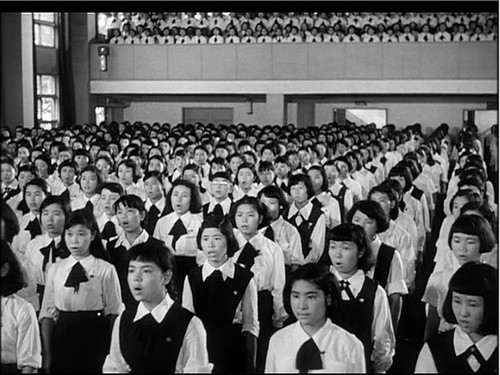Note: This post assumes some familiarity with Gojira. If you aren’t familiar with the film, this post should give you the necessary background.
For every story there is the story itself and there is the way the story is told. In the case of Gojira, the 1954 Japanese film, I’m interested how the story was told; in particular, I’m interested in things that were kept from the audience, at least for a while. In the opening scene, Gojira attacks a boat at sea, but we don’t actually see Gojira. Gojira doesn’t appear on screen until about 20 minutes into the film, which is about 96 minutes long. Why not? How would the film be different if he had appeared in that first scene?
That’s one case. There’s another.
A bit over a third of the way through the film Prof. Yamane’s daughter, Emiko, takes a reporter to see Dr. Serizawa, a scientist to whom she has been betrothed since she was a child. During that visit Serizawa shows her his laboratory, but we don’t see what happens there, though we find out in a flashback later in the film. Why did Honda, the director, initially keep that information from us?
Let’s examine these cases in order.
Why Hide Gojira?
By the time we finally see Gojira he’s attacked several ships and has also attacked Odo Island, killing people, cows, and pigs, and destroying several houses. For the audience there is no mystery about what is happening; the movie, after all, is called Gojira and they know it is about a monster. If they’ve seen the trailer, they know what the monster looks like. If Honda is keeping the audience from seeing Gojira, it cannot be because there is anything secret about him.
Why then, does he not show us Gojira from the beginning?
For one thing, there is a difference between knowing that a particular monster is doing these things, and even knowing what the monster looks like, and actually seeing it (and hearing it). Just what that difference is, and how to talk about it, that’s not obvious to me. But there is a difference.
Given that difference, the fact that Honda is, in effect, allowing the audience to pretend ignorance, is more or less equivalent to putting us in the same position with respect to Gojira most of the people depicted in the film are in. They don’t know what is causing this destruction. In particular, that is the case for Professor Yamane, his daughter Emiko, and Ogata, her boyfriend.
We don’t see Gojira until they do. They are on Odo Island to research an attack that had recently happened there. Gojira appears over a hill:
People start running, of course, and Emiko trips and falls. Ogata comes to her aid and they embrace, briefly, affirming what we learned in the second scene of the film, that they have been dating. No one else in the film sees this. Note that at this point in the film we do not know that Emiko has been betrothed to Serizawa. Though Serizawa has appeared in the film; it was only briefly and not in a way that identified him. He was just a one-eyed man on the dock as the research party departed for Odo Island:
The appearance of Gojira is thus timed so as to create an association between Gojira and the relationship Ogata and Emiko have. We learned that something was going on between them in the second scene, in Ogata’s office after Gojira’s initial attack. When Ogata comes to her aid as she is scared by Gojira, that reinforces our sense of the relationship between them.
The Secret of the Oxygen Destroyer
Now let’s consider the other case. A reporter has heard the Serizawa has been doing research that might be useful in combatting Gojira. Knowing that Emiko is betrothed to Serizawa, the reporter asks her to introduce him. She agrees, and tells Ogata that she’ll (attempt to) tell Serizawa about their relationship.
Serizawa tells the reporter that his research has no relevance to combatting Gojira and refuses to say anything at all about his research. The reporter leaves. Emiko asks him about his research. He agrees to show her his laboratory, but only if she promises not to tell anyone about what she sees.
They go into his basement laboratory, which is dark, full of elaborate apparatus, and slightly sinister. There’s a large fish-filled aquarium in the laboratory. Serizawa places something into the aquarium, flips a switch, and stuff starts to happen. But we don’t see that. All we see is Emiko’s horrified reaction and she buries her head in Serizawa’s shoulder:
The next thing we see is Emiko exiting the lab, followed by Serizawa. He tells her that she’s the only person he’s showed THAT to, whatever that is, and she reaffirms her promise of secrecy. She returns home, obviously upset, but says nothing to Ogata, who is waiting there with Shinkichi – a young guest in the house he’d been helping with his studies. She does tell Ogata, however, that she was unable to tell Serizawa about them.
And then Gojira launches his first attack on Tokyo.
What happened that we didn’t see? Three things. 1) There was a lot of frothing in the aquarium and all the fish were destroyed, with nothing but their skeletons remaining. 2) Serizawa explains that he knows how to make a relatively small device – the so-called Oxygen Destroyer – that could destroy all life in Tokyo Bay, thus destroying Gojira. 3) He also explains that he’s reluctant to do so because he’s afraid that politicians would then force him to build a weapon that could destroy the world – remember, this movie was made less than a decade after the destruction of Hiroshima and Nagasaki by atom bombs and when radioactive fallout from Cold War nuclear testing was a major concern. THAT’s why he’s sworn Emiko to secrecy.
But why did Honda keep this from us? Why did he wait for twenty-five minutes or so to reveal this information in a flashback?
Confronting Serizawa
First, what happened after Emiko had returned from Serizawa’s laboratory? As I have already indicated, Gojira attacks Tokyo for the first time (1). Then there’s a sequence where preparations are made for another attack (2). The city is evacuated and defenses are constructed. There’s an interlude in which Yamane and Ogata quarrel about what should be done with Gojira – Yamane wants to study him and Ogata wants to destroy him – and Yamane throws Ogata out of the house (3). (This is the scene that’s the structural center of the film). Then we have Gojira’s second and far more deadly attack (4). It’s while surveying the wounded in the aftermath of that attack (5) that Emiko decides to break her promise to Serizawa.
What if we’d watched Gojira’s attacks on Tokyo knowing that Serizawa could have made a weapon that would have prevented that, and the Emiko knew that? That knowledge would obviously have complicated our experience of those events, though it’s hard to say just how that would have gone. Would we have been angry with Serizawa for not coming forth? Would we have been angry with Emiko for staying silent? Would we have grappled with Serizawa’s moral dilemma even as we watched Tokyo burn? Who knows? About all I’m willing to commit to is that things would have been more complicated.
While that’s a consideration, I believe there’s more going on. Let’s review what happened once Emiko decided to tell what she knew.
Who did she turn to? Ogata, her beloved. “I can’t stay quiet any longer. I must betray him...It’s a secret I’ve been keeping even from you.” (1:10:44) This is when we learn, though flashback, what happened in Serizawa’s laboratory. The two of them then go to Serizawa (as a couple?) and ask him to use the Oxygen Destroyer against Gojira. It takes a bit of work – there’s a scuffle between Serizawa and Ogata – but Serizawa finally agrees (while listening to a national hymn of peace on television). It is also clear, to Emiko and to us, that Serizawa intends to commit suicide (as well as destroy his notes) so that knowledge of his discovery cannot be used; but he never says so explicitly.
The Gojira Plot and the Marriage Plot
It is worth emphasizing that Emiko’s decision to break her promise came only after she had seen the destruction that Gojira had caused and believed that this was a matter of national importance. Similarly, Serizawa’s decision came while he (along with Ogata and Emiko) was watching a television show that depicted widespread destruction while showing a large children’s choir singing a hymn of peace:
This whole sequence, from Emiko’s decision to reveal the secret to Serizawa’s decision to use his discovery against Gojira, takes about 13 minutes or so (1:10:45 – 1:24:13). It’s one continuous line of development that would have been weakened had we known Serizawa’s secret at the time he revealed it to Emiko. As it is, the sequence underscores the thematic connection between the Gojira plot and the conflict between marriage by betrothal (Emiko and Serizawa) and marriage by personal choice (Emiko and Ogata). Recall that, when she took the reporter to see Serizawa, Emiko had also wanted to tell him about her relationship with Ogata. But Serizawa’s revelation pre-empted that. Now, in revealing Serizawa’s secret to Ogata, Emiko was in effect telling him about her own preference for Ogata.
When Honda kept Serizawa’s revelation of his discovery from us, the audience, he was also, in effect, saying that information was privy to the betrothal relationship between Serizawa and Emiko. Emiko’s betrayal of Serizawa to Ogata, and to us, meant the “transfer” of that bond to Ogata. Their relationship was no longer a secret one. Similarly, Honda kept Gojira hidden from the audience until a point in the film where, shortly after he appeared, the audience saw Ogata and Emiko embrace one another.
Logically the Gojira plot and the romance plot are two separate lines of action which just happen, contingently, to coincide at points. Thus, when the film was revised for American audiences (as Godzilla: King of the Monsters), the romance plot was all but eliminated, leaving the Gojira plot unaffected (though somewhat differently arranged). But the structure of Gojira is not governed by logic; it is governed by myth-logic. And in the myth-logic of Japanese culture, these plots are different sides of the same coin.
Gojira is doing double duty. Yes, he is an affective “magnet” – T. S. Eliot’s objective correlative? – for anxiety raised by nuclear testing. But he is also a magnet for anxiety aroused by the social change implied in a shift from traditional arranged marriages to marriages based on the personal preferences of the couple. Thus the destruction of Gojira also becomes an affirmation marriage by individual choice.
And yet, there is an obvious sense in which the movie manages to avoid that conflict. Ogata and Emiko are keenly aware of the conflict. But Emiko never broaches the issue with Serizawa and Ogata never broaches the issue the Emiko’s father, Prof. Yamane. Each had intended to discuss the matter and in both cases the discussion never happens. In both cases the marriage discussion was displaced by a discussion related to the Gojira plot: Serizawa tells Emiko about his research; Ogata and Yamane quarrel about what should be done with Gojira. In myth-logic Yamane’s desire to study Gojira rather than destroy him is equivalent to a preference for traditional marriage while Ogata’s desire to destroy Gojira represents a preference for a new mode of marriage.




No comments:
Post a Comment